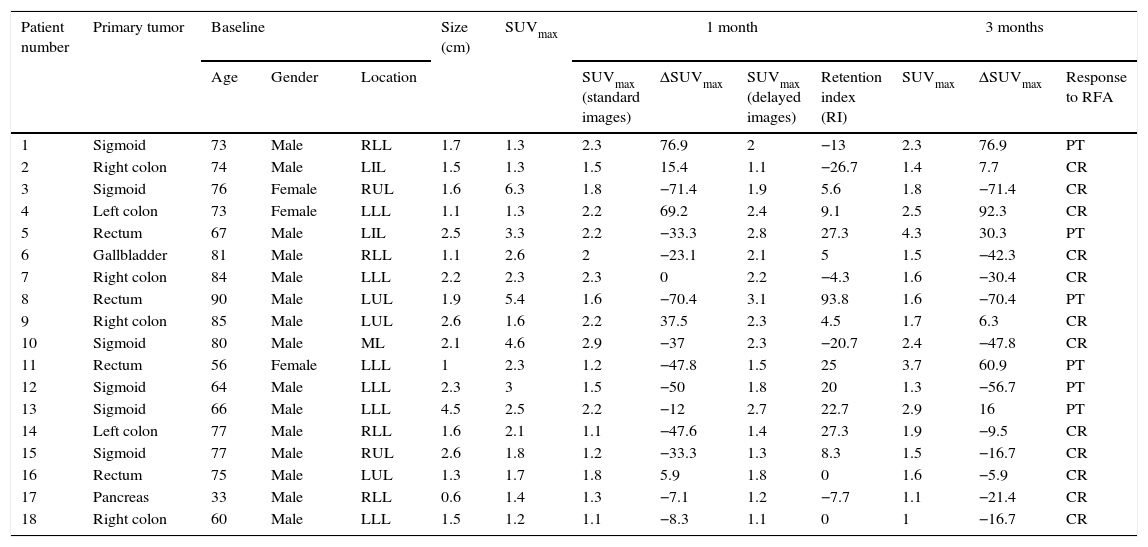To establish the usefulness of dual time-point PET/CT imaging in determining the response to radiofrequency ablation (RFA) of solitary lung metastases from gastrointestinal cancer.
Materials and methodsThis prospective study included 18 cases (3 female, 15 male, mean age 71±15 yrs) with solitary lung metastases from malignant digestive tract tumors candidates for RFA. PET/CT images 1h after injection of 4.07MBq/kg of 18F-FDG (standard images) were performed at baseline, 1 month, and 3 months after RFA. PET/CT images 2h after injection centered in the thorax at 1 month after RFA were also performed (delayed images). A retention index (RI) of dual time-point images was calculated as follows: RI=(SUVmax delayed image−SUVmax standard image/SUVmax standard image)*100. Pathological confirmation of residual tumor by histology of the treated lesion was considered as local recurrence. A negative imaging follow-up was considered as complete response.
ResultsLocal recurrence was found in 6/18 lesions, and complete response in the remaining 12. The mean percentage change in SUVmax at 1 month and at 3 months showed a sensitivity and specificity for PET/CT of 50% and 33%, and 67% and 92%, respectively. The RI at 1 month after RFA showed a sensitivity and specificity of 83% and 92%, respectively.
ConclusionsDual time point PET/CT can predict the outcome at one month after RFA in lung metastases from digestive tract cancers. The RI can be used to indicate the need for further procedures to rule out persistent tumor due to incomplete RFA.
Establecer la utilidad de las imágenes PET/TC en 2 tiempos en la determinación de la respuesta a la ablación por radiofrecuencia (RFA) de las metástasis pulmonares de tumores digestivos.
Material y métodosEstudio prospectivo con 18 casos (3 mujeres, 15 varones) y edad media de 71±15 años con metástasis pulmonar única de cáncer digestivo candidato a tratamiento mediante RFA. Se realizaron imágenes PET/CT 1h tras inyección de 4,07MBq/Kg de 18F-FDG (imagen estándar) basal, un mes y 3 meses después de la RFA y una imagen tardía 2h tras la inyección centrada en tórax un mes después de la RFA. Se calculó el índice de retención (RI): RI=(SUVmáx imagen tardía−SUVmáx imagen estándar/SUVmáx imagen estándar)*100. La recurrencia local se confirmó con estudio histológico de la lesión tratada con RFA. Un resultado negativo en las pruebas de imagen durante el seguimiento se consideró como respuesta completa.
ResultadosSe diagnosticó recidiva local en 6/18 lesiones y respuesta completa en 12/18. El cambio porcentual medio de SUVmáx al mes y a los 3 meses mostró una sensibilidad y especificidad para evaluar la respuesta a la RFA de 50% y 33% y 67% y 92%, respectivamente. El RI un mes posradiofrecuencia mostró una sensibilidad y especificidad del 83% y 92%.
ConclusionesLas imágenes en 2 tiempos con PET/TC un mes posradiofrecuencia pueden predecir el resultado de la RFA de las metástasis pulmonares de origen digestivo. El RI se puede utilizar para indicar la necesidad de otros procedimientos para descartar recurrencia tumoral debido a una RFA incompleta.
Article

Revista Española de Medicina Nuclear e Imagen Molecular (English Edition)










